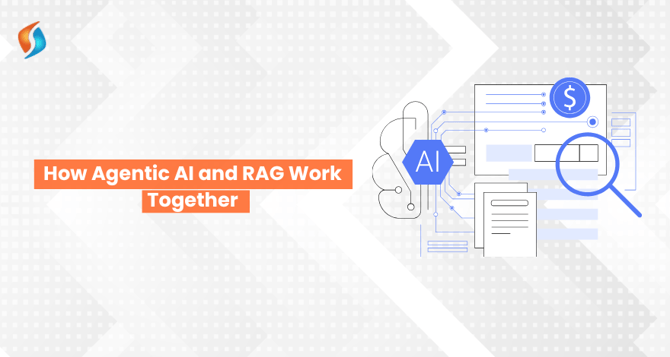How Agentic AI and RAG Work Together to Transform Demand Generation
The integration of RAG and Agentic AI can make a big change in demand generation by providing personalization and intelligent decision-making. This blog explores how agentic AI and RAG can build real-time, data-driven, faster, and more effective marketing systems.

In the complex and data-centric business sector, Demand generation is much more than just filling the top of the funnel. It involves sending the right message to the right people at the right time.
Traditional marketing automation tools, while useful, often operate on rigid workflows, outdated data, and basic segmentation logic. As a result, this causes missed opportunities, irrelevant outreach, and wasted resources.
Traditional marketing automation tools operate on inflexible processes, outdated data, and basic segmentation logic. These things can result in missed opportunities, baseless outreach, and wastage of important resources.
Users expect customization, relevance, speed, and intelligence. To meet these expectations, demand gen strategies need to evolve from static sequences to autonomous, context-aware systems that can think, learn, and act in real-time.
This is where Agentic AI and Retrieval-Augmented Generation (RAG) come into play. Individually powerful but exceptional when combined, these technologies are changing the way modern companies generate, nurture, and convert demand.
In this article, you will learn how Agentic AI and RAG work, why they complement each other, and how they can build an AI solution that is scalable and can perform intelligent demand generation with real-time data and dynamic workflows.
 Generate
Key Takeaways
Generating...
Generate
Key Takeaways
Generating...

- Traditional AI systems are unable to meet the personalized requirements of businesses regarding demand generation.
- Agentic AI can plan, control, and perform marketing processes that are in line with particular objectives without any human help.
- AI can retrieve precise, brand-specific, and current data from internal knowledge sources such as CRMs, product documents, and CMSs with the help of RAG (retrieval-augmented generation).
- Agentic AI and RAg work together to deliver excellent autonomous solutions that can provide custom outreach, lead generation, and content generation.
What is Agentic AI?
Software that can interact with tools and data with little assistance from humans is known as Agentic AI. Agentic AI, sometimes referred to as AI agents, is a type of artificial intelligence that focuses on goal-oriented behavior. It may complete tasks by generating a set of instructions and carrying them out on its own.
The creative powers of a large language model (LLM) can be integrated with automation to create agentic AI. In order to implement agentic AI, you need to build a system that gives an LLM access to external tools and algorithms that tell the AI agents how to utilize those tools.
What is RAG (Retrieval Augmented Generation)?
One method for creating LLM-powered applications is called Retrieval-Augmented Generation (RAG). It makes use of an outside knowledge source to give the LLM pertinent background information and lessen hallucinations.
A generative component (an LLM) plus a retrieval component (usually made up of an embedding model and a vector database) make up a basic RAG pipeline. To give the LLM more context, the user question is used to do a similarity search across the indexed articles at inference time. This allows the retrieval of the documents that are most comparable to the query.
Typical limitations of the RAG Implementations
-
Only one external knowledge source is taken into account by the naive RAG process. However, certain solutions might need external tools and APIs, such as web searches, and some solutions might need two external information sources.
-
Since they are a one-shot solution, context is only collected once. The quality of the context that was retrieved is not justified or validated.
Integration of Agentic AI and RAG (Retrieval Augmented Generation)
Integration of Agentic AI and RAG provides powerful solutions. Here, Agentic AI works like the brain of the system; it can plan, decide, and execute. On the other hand, RAG works as the memory that feeds the brain with real-time and relevant information and brand-specific knowledge.
Agentic AI can set goals and create action plans, but it cannot access up-to-date data. Without the latest data, agentic AI can make strategies based on outdated data.
Conversely, Retrieval Augmented Generation is informative, but it does not have a direction or goal. It can retrieve precise information from documents, knowledge bases, or CRMs, but lacks the ability to act on that data independently.
RAG equips the agent with accurate contextual intelligence, user behavior, product updates, and competitor insights, while the agent uses that knowledge to drive personalized campaigns, trigger sequences, and adjust strategies in real-time.
This integration can build reliable, autonomous demand-generation systems that are strategic and intelligent as well. With the help of Agentic AI and RAG, you’re no longer just automating tasks. You’re preparing end-to-end marketing flows that can think, adapt, and deliver with precision.
Common Bottlenecks and Their Solution in Demand Generation
Traditional systems and workflows often introduce inefficiencies that reduce pipeline velocity and lead conversion. Effective demand generation requires accuracy, customization, and quick response.
The following are some common blockers in demand generation and how the integration of Agentic AI and RAG addresses this problem.

1. Postponed Content Creation
When producing campaign assets for various personas, phases, and industries, content teams experience delays. As a result, GTM execution is slowed down, and campaign relevance is reduced.
By producing initial drafts based on customer use cases, updated product documentation, and messaging guidelines obtained from RAG, agentic AI speeds up the generation of content. It shortens the turnaround time for outbound content, one-pagers, and sales decks.
2. Prioritization and Lead Scoring
Outdated activity triggers and simple firmographic data are the foundation of legacy lead scoring models. As a result, high-fit leads are either ignored or incorrectly classified. Agentic AI automatically re-prioritizes leads by analyzing multi-source intent signals, such as product usage, content engagement, and previous communication.
RAG provides access to up-to-date data, enhancing sales alignment and decreasing response latency to opportunities that are ready for sale.
3. Personalization at Scale
Delivering personalized content to a high number of leads is a challenge for marketing teams. Low engagement rates are the outcome of template-based communications and static segmentation.
Agentic AI can produce dynamic, persona-specific communications in real-time when given access to contextual data through RAG. It leverages behavioral data, content preferences, and CRM account-level information to customize email outreach, landing pages, and nurturing campaigns at scale.
4. Fragmented Demand Generation Stack
Data silos and uneven campaign execution are caused by disjointed solutions (marketing automation, CRM, enrichment platforms, and engagement tools).
By integrating with APIs, agentic AI serves as an operational layer that connects tools. Consistent communications, synced workflows, and unified reporting are made possible by RAG's consolidated access to data across platforms.
5. Manual Follow-Ups and CRM Updates
Manually recording interactions, updating statuses, and overseeing follow-up duties take up a lot of time for sales and marketing teams. This results in data gaps and less attention being paid to high-value tasks.
Agentic AI simplifies and automates follow-up procedures and CRM updates. Without requiring human input, RAG integration allows it to access past interactions, account notes, and task history to guarantee correct documentation and prompt next steps.
Technical Architecture of Agentic AI and RAG Integration
The combined strength of RAG and Agentic AI is organized into a modular, scalable framework to operationalize intelligent demand generation. The essential elements that combine to provide context-aware, goal-driven automation are broken down below.
1. Layer of Agentic Orchestration
The agentic artificial intelligence layer is at the core and is in charge of independently organizing and carrying out demand-generating tasks. Usually, frameworks like AutoGPT, LangChain, or custom stacks are used to build this. In addition to having predetermined goals, such as qualifying leads, creating follow-ups, or initiating customized campaigns, agents can also initiate workflows in response to changing circumstances.
2. RAG Backend
The Retrieval-Augmented Generation layer enables real-time access to business-specific knowledge. It includes:
- A Vector Database that stores semantically indexed data such as product documentation call transcripts, or CRM notes.
- A Retrieval Index, which lets the language model fetch relevant context at inference time. This ensures responses and decisions are grounded in live data rather than static training.
3. APIs and System Integrations
This layer connects the AI system with operational data sources and execution tools:
- CRM for lead/account data and activity logs.
- CMS & Knowledge Bases will provide contextual assets.
- Engagement Platforms for email, SMS, and chat execution.
- Analytics Tools for behavioral insights and performance tracking.
- APIs enable bidirectional communication—pulling relevant data and pushing actions or updates in real time.
4. Language Model Layer
This is the generative core that drives interaction. The system can be configured to use any foundation model based on requirements and data sensitivity:
- OpenAI GPT models for broad use cases.
- Anthropic Claude, Mistral, or custom fine-tuned models for compliance-sensitive or domain-specific tasks.
This layer powers content generation, reasoning, and dialogue-based interactions.
Conclusion
By combining the strategic flexibility of Agentic AI with the contextual intelligence of RAG, businesses can go beyond reactive marketing to the next stage of proactive, data-driven expansion.
Scale Smarter with RAG-Based Demand Gen
Combine deep retrieval with generative AI to craft outreach that actually connects.
With the help of AI-powered systems that learn and adjust with each encounter, scalable personalization, accurate lead prioritizing, and flawless execution are possible.
If you're ready to modernize your demand generation with intelligent systems that act with purpose and context, Signity Solutions, with its innovative AI development solutions, is your technology and strategy partner.
Our experts have years of knowledge and hands-on practice in building AI solutions. We help businesses architect and implement transformation, whether it’s increasing pipeline velocity, reducing CAC, or improving lead conversion rates. Contact us today to upgrade your business with our exceptional solutions.
Frequently Asked Questions
Have a question in mind? We are here to answer. If you don’t see your question here, drop us a line at our contact page.
What is Agentic RAG, and how can it change business operations?
![]()
Agentic RAG adds AI agents to the RAG pipeline to increase flexibility and information retrieval. The capabilities of these agents include task automation, external data access, customizable outputs, and performance evolution through ongoing learning.
How do Agentic AI and RAG work together?
![]()
Agentic AI acts like a planner or decision-maker, while RAG provides it with the knowledge it needs to make informed decisions. Agentic AI works as the brain, and RAG works as the memory.
What is the difference between Native RAG and agentic RAG?
![]()
Traditional RAG generates text and retrieves information using a large language model LLM, but Agentic RAG incorporates AI agents to improve retrieval, reasoning, and decision-making.
Can these AI systems be integrated into existing systems?
![]()
Yes, Agentic AI platforms are designed to connect via APIs to CRMs like HubSpot and Salesforce and tools like Mailchimp, Slack, and CMS platforms. This allows seamless automation across the funnel.














